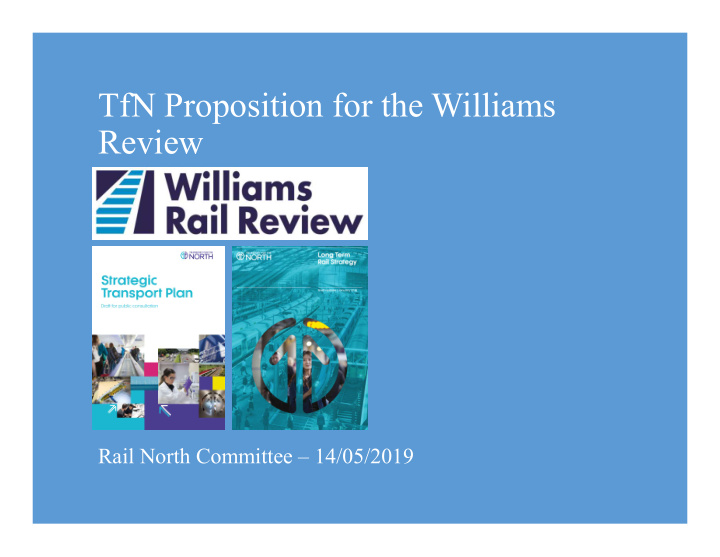



TfN Proposition for the Williams Review Rail North Committee – 14/05/2019
Background Information Williams Review A root and branch review of Britain’s railway, independently chaired by Keith Williams Looking at the structure of the whole rail industry and the way passenger services are delivered Evidence papers Deadline for Deadline for full Government white Williams Review released and wider interim response responses on Reform of rail paper containing announced – 20 th call for evidence – including additional propositions for the industry to begin - recommendations – September 2018 March – April evidence – 30 th rail industry – 31 st 2020 Autumn 2019 2019 April 2019 May 2019 Influence Respond React TfN Response An opportunity to feed a coordinated proposition for the North of England into the Review Consulting all authorities and presenting a united response for the benefit of all rail customers TfN Executive Refine and submit Work with wider Initial evidence Respond to Interim response to Board and Officer TfN proposition rail industry to review and gap Government white call for evidence – Reference Group following RNC implement analysis – 11 th paper – Autumn 30 th April 2019 input – 31 st May workshop – 2 nd recommended April 2019 2019 May 2019 2019 reform - 2020 Today – consultation with Rail North Committee
The TfN Proposition – Part 1 Basis for TfN Existing position proposition Vertical separation Vertically integrated, tracks Vertically and trains run by separated same entity Risks and dependencies – capability Why? – recent timetable issues / desire to take over, manage and For the North – ‘TfN Infrastructure’ demonstrated the key failings of maintain a £multi-billion portfolio of collaborating with an operator across disaggregation physical assets the same geography to lobby for more National model – localisation of infrastructure investment and target it Outcomes – stronger policy infrastructure investment and where the benefits will be greatest for alignment (including the skills management to sub-national customers in the North agenda), integrated investment of ‘families’ available funding Horizontal integration Single, large Larger numbers national rail of smaller operator operators Risks and dependencies – micro- Why? – too many operators across For the North – ‘TfN Trains’ manage / franchises potentially add complexity mixed geographies lacking local operate all services (except long rather than simplicity – conflicting accountability distance) and procure micro-franchises priorities between regions to deliver specific benefits (e.g. National model – a handful of Greater Manchester Trains, North East Outcomes – a simpler network ‘umbrella’ sub-national operators Trains etc.) – TfN to manage cross- providing better value for all with micro-franchises to deliver boundary conflicts customers including consistent fares benefits for local communities and integrated ticketing Key requirement – the proposed model will require an independent national ‘system operator’ to coordinate freight / long distance / timetabling and enable the sub-national bodies to remain outward facing
The TfN Proposition – Part 2 Basis for TfN Existing position proposition Length of arrangements Time limited In perpetuity to 2 years Why? – Frequent cycles of change Risks and dependencies – Longer perceived to be stifling investment For the North – TfN overseeing all arrangements means less competition and innovation services in perpetuity and procuring and so greater regulation may be micro-franchises (e.g. Greater required National model – longer Manchester Trains) on long term (circa arrangements (circa 15 years) with 15 year) arrangements with clear break Outcomes – greater incentive for clear break point reviews to avoid points to drive stability and investment investment which can be targeted complacency and stagnation – where it is needed most flexibility is key Decision making and accountability Centralised, Devolved, at at Secretary local authority of State level or mayoral level Risks and dependencies – question For the North – TfN set policy for Why? – a culture of blame and a lack over where the financial risk sits and both track and train and oversee / of true accountability – local bodies of local capability to manage such coordinate local decision making by held to account with no ability to complex systems business units for specific geographies dictate change – have political oversight but at arms Outcomes – stronger policy National model – decision making length to allow day-to-day operation at alignment (environment, social and accountability devolved to sub- the technical level for the long term economy), local accountability but national transport bodies benefit of the railway with the ability to dictate change
Recommend
More recommend